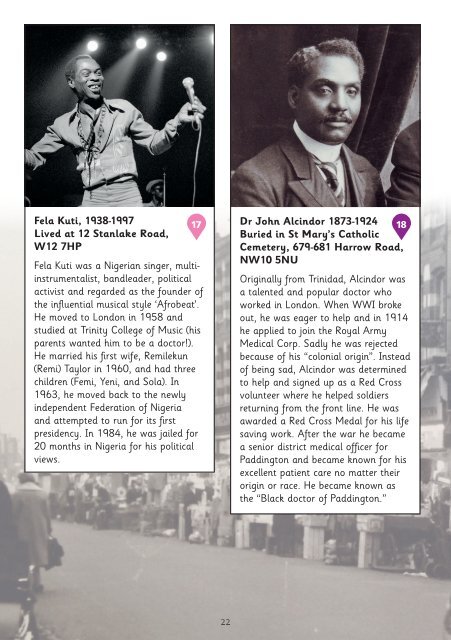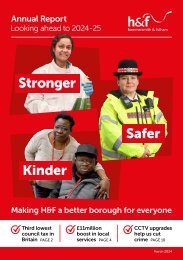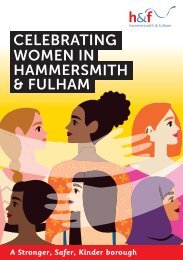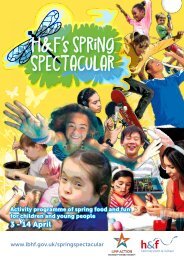Proud of our Black History
Celebrating Hammersmith & Fulham’s diversity and the historic figures who have helped make this such a special borough.
Celebrating Hammersmith & Fulham’s diversity and the historic figures who have helped make this such a special borough.
You also want an ePaper? Increase the reach of your titles
YUMPU automatically turns print PDFs into web optimized ePapers that Google loves.
HORRIBLE HISTORY<br />
Unfortunately, not everybody who lived in Hammersmith & Fulham<br />
thought that <strong>Black</strong> people and other ethnic minorities should have the<br />
same rights as white people. When they were alive these opinions were<br />
not uncommon, but today we know they are wrong. Below are examples<br />
<strong>of</strong> famous local Historic Figures who played a negative role in the UK’s<br />
<strong>Black</strong> history<br />
Fela Kuti, 1938-1997<br />
Lived at 12 Stanlake Road,<br />
W12 7HP<br />
Fela Kuti was a Nigerian singer, multiinstrumentalist,<br />
bandleader, political<br />
activist and regarded as the founder <strong>of</strong><br />
the infl uential musical style ‘Afrobeat’.<br />
He moved to London in 1958 and<br />
studied at Trinity College <strong>of</strong> Music (his<br />
parents wanted him to be a doctor!).<br />
He married his fi rst wife, Remilekun<br />
(Remi) Taylor in 1960, and had three<br />
children (Femi, Yeni, and Sola). In<br />
1963, he moved back to the newly<br />
independent Federation <strong>of</strong> Nigeria<br />
and attempted to run for its fi rst<br />
presidency. In 1984, he was jailed for<br />
20 months in Nigeria for his political<br />
views.<br />
17 Dr John Alcindor 1873-1924 18<br />
Buried in St Mary’s Catholic<br />
Cemetery, 679-681 Harrow Road,<br />
NW10 5NU<br />
Originally from Trinidad, Alcindor was<br />
a talented and popular doctor who<br />
worked in London. When WWI broke<br />
out, he was eager to help and in 1914<br />
he applied to join the Royal Army<br />
Medical Corp. Sadly he was rejected<br />
because <strong>of</strong> his “colonial origin”. Instead<br />
<strong>of</strong> being sad, Alcindor was determined<br />
to help and signed up as a Red Cross<br />
volunteer where he helped soldiers<br />
returning from the front line. He was<br />
awarded a Red Cross Medal for his life<br />
saving work. After the war he became<br />
a senior district medical <strong>of</strong>fi cer for<br />
Paddington and became known for his<br />
excellent patient care no matter their<br />
origin or race. He became known as<br />
the “<strong>Black</strong> doctor <strong>of</strong> Paddington.”<br />
Sir Nicholas Crisp,<br />
1599-1666<br />
Crisp was a wealthy merchant and<br />
royalist who supported Charles I<br />
during the English Civil War. He is<br />
famous for his brickworks. Crisp was<br />
also involved in the Slave Trade.<br />
Using glass beads he made on site<br />
at his house, Crisp bought and sold<br />
slaves across the Atlantic.<br />
Frederick Marryat,<br />
1792-1848<br />
Today, Marryat is famous for<br />
his children’s stories about naval<br />
adventures during the height <strong>of</strong> the<br />
British Empire. His father, Joseph<br />
Marryat, was a known slave-owner<br />
and fought against the end <strong>of</strong> the<br />
Slave Trade. Like his father, Frederick<br />
defended the Slave Trade and believed<br />
that Africans were not ready to be<br />
free. His stories also contained wrong<br />
and hurtful descriptions <strong>of</strong> <strong>Black</strong><br />
people.<br />
22 23


















